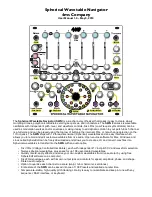
Page 3
Table of Contents
Stage II Edition
FOREWORD from Mike Adams ............................... 4
THE BASICS
How to use this Manual .......................................
5
Setup and Connections ........................................
5
Overview and Features ........................................
7
Signal Flow ....................................................................
9
Basic Operation ......................................................... 10
THE COMPONENTS
A. Oscillator Section ............................................... 11
B. Filter Section ......................................................... 13
C. Envelope Generators Section .................... 15
D. Modulation Section .......................................... 17
E. Output Section .................................................... 18
F. Keyboard & LH Controllers .......................... 19
G. Input/Output Panel ..........................................
20
H. Interface Panel ..................................................... 21
THE USER INTERFACE
Preset Mode ................................................................
23
Master Mode ............................................................... 26
A. Menus .................................................... 26
B. Advanced Presets ...........................
35
C. System Exclusive ............................. 41
D. System Utilities..................................
44
THE USER INTERFACE (con’t)
Performance Sets ................................................................ 50
Activating the Arpeggiator and Latch ....................
52
How the LP handles MIDI .............................................
54
APPENDICES
A – Master Mode Menu Tree ......................................
58
B – LFO Sync Modes .....................................................
59
C – Arpeggiator Clock Source .................................
60
D – The Calibration Preset ........................................
61
E – Accessories .................................................................
62
F – Tutorial .............................................................................
63
G – MIDI Implementation Chart ............................
68
H – Service & Support Information .......................
69
I – Caring for the Little Phatty ...................................
69
J – Using the CP-251 with the Little Phatty .......
70
K – Specifi cations ...............................................................
72
GLOSSARY ......................................................................................
73
STAGE II PRESETS .......................................................................
77


































